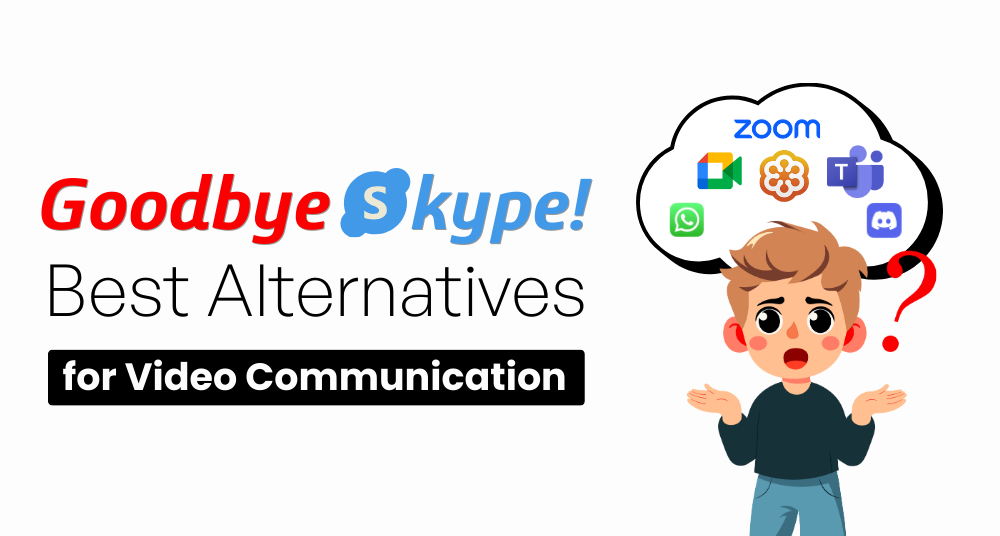After 22 years of connecting people across the globe, Microsoft has officially bid farewell to its iconic video and chat platform, Skype. Once the go-to choice for virtual calls and online meetings, Skype is now being phased out as Microsoft shifts its full focus to Microsoft Teams — a more advanced, collaboration-driven tool built for modern workplaces. While the transition makes sense for businesses already using Microsoft 365, many individuals and small teams are now left searching for secure and reliable alternatives.
In today’s digitally connected world, video conferencing is more important than ever — whether it’s for remote work, online classes, client meetings, or catching up with friends and family. The demand for user-friendly, high-quality, and privacy-focused platforms has grown exponentially. That’s why in this guide, we’ve curated the top Skype alternatives that offer seamless experiences, strong security, and essential features like screen sharing, recording, chat integration, and more.
Whether you’re a startup, an educator, or a casual user, there’s a perfect tool for your needs. From Zoom and Google Meet to niche platforms like Ring central and whereby, discover which video conferencing tool fits best for your virtual communication needs in a post-Skype world.
Goodbye Skype: Understanding Microsoft’s Strategic Shift
Microsoft’s decision to shut down Skype marks a major pivot in its communication strategy. Once a pioneer in online video calling, Skype struggled to keep pace with modern collaboration needs. With the rise of hybrid work, Microsoft Teams emerged as a more powerful, all-in-one platform, integrating chat, video meetings, file sharing, and app integration. By focusing its resources on Teams, Microsoft aims to deliver a more unified and efficient experience for businesses and users. This shift highlights Microsoft’s commitment to modern workplace solutions and signals the end of an era for Skype’s once-dominant presence in digital communication.
Best Skype Alternatives for Seamless Communication
- Zoom
- Mocrosoft Teams
- Google Meet
- GoToMeeting
- Viber
- Jitsi
- RingCentral
- Discord
- Webex
- Slack
- Signal
- Telegram
- Line
- Zoho Meeting
- Whereby
- Hike Messenger
- iMO
- Tango
- Zangi
- Botim
Zoom
Zoom is a popular video conferencing platform and one of the most reliable Skype alternatives. Known for its easy-to-use interface, breakout rooms, screen sharing, and virtual backgrounds, it’s a favorite among professionals, educators, and event hosts for seamless communication and collaboration.
Microsoft Teams
Microsoft Teams is one of the top alternatives to Skype that integrates chat, meetings, file storage, and productivity tools. Ideal for remote work and large teams, it streamlines collaboration through Microsoft 365 integration and ensures effective communication across departments and time zones.
Google Meet
Google Meet is a secure and efficient Skype-like app for hosting video calls directly from your browser. It offers live captioning, screen sharing, and calendar integrations, making it a simple and scalable solution for schools, businesses, and remote teams needing high-quality video communication.
GoToMeeting
GoToMeeting is a professional-grade Skype competitor used globally for business video meetings and webinars. It offers features like automatic transcription, recording, and HD conferencing. It’s ideal for corporate teams looking for reliable and secure online meeting solutions without the complexity of traditional communication tools.
Viber
Viber is a versatile group chatting app with voice, video, and instant messaging options. It supports end-to-end encryption and multimedia sharing, making it suitable for both personal and small business use. Viber’s intuitive interface and free international calls make it a preferred option for everyday communication.
WhatsApp serves as an accessible and widely-used Skype alternative with encrypted voice and video calls, text messaging, and media sharing. It supports group chats and broadcasts, making it a great option for users who want a lightweight, dependable tool for both personal and professional messaging needs.
Jitsi
Jitsi stands out among open-source alternatives to Skype, offering free video conferencing without login or download requirements. Its focus on privacy, flexibility, and secure communication makes it a top pick for users looking to host meetings with full control and minimal setup.
RingCentral
RingCentral is a cloud-based Skype-like app offering unified communication tools such as messaging, video conferencing, and a virtual phone system. It’s designed for enterprise-level collaboration and enables remote teams to stay connected through a secure and scalable platform that competes strongly with Skype in the business world.
WeChat is a multifunctional Skype competitor widely used in China and beyond for messaging, calling, and digital payments. It allows users to send text, voice notes, and make video calls, all while offering unique features like mini-programs and location sharing within one communication hub.
Discord
Discord is a fun and feature-rich group chatting app used by gamers, creators, and businesses alike. With voice channels, video chat, bots, and custom servers, it’s an ideal choice for community building and casual team communication beyond traditional video conferencing platforms like Skype.
Webex
Webex is a business-grade Skype alternative built for professional meetings, webinars, and online training sessions. It includes real-time translations, screen sharing, and breakout sessions, making it suitable for global teams that need high-quality communication tools that go beyond basic video calls.
Slack
Slack offers a dynamic workspace and is one of the most effective alternatives to Skype for team messaging. With channels, file sharing, app integrations, and voice/video calls, Slack enhances real-time communication and productivity across startups, enterprises, and remote teams worldwide.
Signal
Signal is a privacy-first Skype-like app focused on secure messaging and encrypted voice/video calls. It’s ideal for users who prioritize data protection and confidentiality in their communications, making it a lightweight and ethical choice for secure one-on-one or group conversations.
Telegram
Telegram is a fast-growing Skype competitor that supports cloud-based messaging, large group chats, and multimedia sharing. Its unique features include bots, channels, and secret chats, offering greater flexibility and control for both casual users and online communities seeking a modern communication app.
Line
Line is a colorful and social group chatting app offering voice/video calls, stickers, and social timelines. Popular in Japan and Southeast Asia, Line also includes mobile payments, games, and news, creating a fun, all-in-one alternative for users looking for more than just messaging.
Zoho Meeting
Zoho Meeting is a secure and simple Skype alternative for online meetings and webinars. Designed with a focus on privacy, it supports screen sharing, RSVP scheduling, and in-session chat, making it a practical choice for small businesses and educators seeking an easy communication solution.
Whereby
Whereby is a user-friendly browser-based alternative to Skype that allows one-click video meetings without downloads. With features like screen sharing, custom branding, and integrations with Google and Outlook, it’s ideal for freelancers, startups, and teams looking for a lightweight video calling solution.
Hike Messenger
Hike Messenger was once a trending Indian Skype-like app that combined messaging, local stickers, and offline chat. Though no longer active, it was a creative attempt at offering a localized, data-friendly alternative for chatting and sharing in regions with limited internet access.
iMO
iMO is a lightweight Skype competitor designed for fast messaging and video calling, especially on low-bandwidth networks. It’s popular in regions where internet connectivity is limited and offers a streamlined experience for users looking for simple, no-frills video chat functionality.
Tango
Tango is a video-first group chatting app known for its live streaming features and interactive content. Besides calls and messaging, users can share moments, play games, and earn through virtual gifts, making it more engaging than traditional Skype-like apps.
Zangi
Zangi is a private and secure Skype alternative offering low-data voice and video calls, even on slow connections. It doesn’t store user data on servers, making it perfect for privacy-conscious users who want reliable communication without compromising their digital footprint.
Botim
Botim is a secure and easy-to-use alternative to Skype popular in countries with VoIP restrictions. It offers voice/video calls and instant messaging across multiple platforms and is known for bypassing internet limitations in the Middle East and Asia, making it a valuable tool for international communication.
The Post-Skype Era: A Golden Chance for Innovative Startups
The fall from dominance of once-unshakable platforms like Skype signals more than just a shift in user preference—it marks a golden window for innovation. Skype, once the frontrunner in online communication, struggled to evolve with the changing digital landscape. Its dated user interface, limited mobile optimization, and inconsistent call quality created frustration among users who now expect fast, intuitive, and feature-rich solutions.
This market vacuum has become fertile ground for agile startups and forward-thinking product teams. The rise of remote work, virtual events, and hybrid offices has multiplied the demand for flexible communication tools. From educators and telehealth providers to corporate teams and gaming communities, everyone is searching for reliable alternatives that offer security, seamless UX, and smart integrations.
Startups now have the chance to build platforms that prioritize mobile-first access, browser-based meetings, end-to-end encryption, and AI-driven enhancements like live captions and meeting summaries. With technologies like WebRTC and scalable cloud infrastructure more accessible than ever, the barrier to entry is lower. What’s needed is sharp focus, a user-first mindset, and the courage to build what Skype never did—modern video meeting platforms that feel like they belong in 2025, not 2010.
From Idea to Launch: Steps to Create a Scalable Video Meeting Platform
Turning an idea into a functional, scalable video conferencing product requires more than development—it demands vision, planning, and execution. Here’s a step-by-step breakdown to transform your concept into a real-world solution:
Identify the Problem & Target Audience
Don’t try to be everything to everyone. Focus on a niche audience—like remote teams, educators, or healthcare providers—and solve their specific pain points. Whether it’s better privacy, faster onboarding, or more engaging user interfaces, know exactly what problem your platform will solve.
Define the Core Features
Your MVP (Minimum Viable Product) should include must-have functionalities such as high-quality video/audio calling, screen sharing, chat, and recording. Avoid feature overload in early stages—focus on stability and ease of use.
Select the Right Technology Stack
Use WebRTC for real-time video and audio communication, along with a backend powered by Node.js or Django. Pair this with frontend frameworks like React or Vue, and host on scalable cloud platforms like AWS, Azure, or Akamai to ensure high availability and global reach.
Design with Scalability and UX in Mind
A clean UI, intuitive controls, and quick load times are essential. Make the platform device-agnostic and accessible via browsers without mandatory downloads. Consider future scalability with microservices architecture.
Test Thoroughly Before Launch
Perform rigorous testing—unit tests, performance tests, and user acceptance tests—to iron out bugs and optimize performance under different network conditions.
Go Live with a Targeted Beta
Launch to a limited group of early adopters. Gather feedback quickly, iterate on improvements, and prepare your infrastructure for increased traffic before a public release.
Building a scalable video meeting platform is not just about the tech—it’s about delivering seamless communication experiences that users trust and enjoy.
From MVP to Market Leader: Growth Hacking Strategies for New Platforms
Launching your product is just the beginning. To stand out in a competitive landscape filled with Zoom, Google Meet, and other Skype competitors, your startup must embrace smart, creative, and data-backed growth strategies.
Adopt a Freemium Model
Let users access core features for free, with optional upgrades for pro features like unlimited meeting time, cloud recording, or branded meeting rooms. This encourages trial and conversion without upfront friction.
Create a Feedback Loop
Set up in-app surveys, email follow-ups, and user communities to gather real-time insights. Use this data to improve usability, fix bugs quickly, and ship features that users actually want.
Invest in Performance Marketing & SEO
Target long-tail keywords like “Skype like apps for startups” or “secure video calling platform.” Run Google Ads and LinkedIn campaigns for niche audiences like HR teams, online tutors, or consultants.
Build Virality Into the Product
Integrate simple invite systems, branded meeting links, and referral programs. Every new user brought in by an existing user becomes a growth engine.
Leverage Integrations and API Access
Allow your platform to connect with Slack, Trello, Microsoft 365, or other tools. This not only boosts value but encourages companies to embed your product into their workflows.
Secure Press & Social Proof
Pitch your platform to tech blogs, reviewers, and SaaS influencers. Add client logos, reviews, and testimonials to boost trust.
Use Analytics to Fuel Retention
Tools like Mixpanel or Hotjar can reveal drop-off points and friction areas. Optimize onboarding flows and in-app guidance to increase retention and lifetime value.
Scaling from MVP to market leader is all about momentum. With the right mix of technical excellence and growth hacking, your platform can redefine communication for the next generation.
Real-World Scenarios for Selecting a Reliable App Development Team
Choosing the right partner can make or break your digital product. Here are six real-world scenarios where selecting a reliable app development team is critical:
Launching a Startup on a Tight Timeline
When speed-to-market is essential, you need a team experienced in agile development and MVP launches to help you move fast without sacrificing quality.
Scaling an Existing App with New Features
If your current app needs complex upgrades or integrations, a reliable development team ensures seamless transitions and feature expansion without disrupting users.
Switching from an Underperforming Vendor
When your existing developers aren’t delivering as promised, finding a transparent and accountable App Development Company becomes crucial for regaining momentum.
Building a Cross-Platform App
For businesses targeting both iOS and Android audiences, choosing a team skilled in frameworks like Flutter or React Native ensures consistent performance across devices.
Maintaining Data Security and Compliance
In industries like healthcare or finance, a team familiar with GDPR, HIPAA, or similar regulations is vital to build apps that are secure and compliant.
Turning a Unique Idea into Reality
When you’re innovating with a fresh concept, you need developers who not only understand code but can think strategically and help validate your idea with the right tech stack.
Related Blog: How to Build a Video Conferencing App Like Zoom
Frequently Asked Questions [FAQ’S]
Why did Microsoft shut down Skype?
Microsoft officially discontinued Skype on May 5, 2025, after 23 years of service. The decision was driven by a strategic shift to focus on Microsoft Teams, which offers a more integrated and modern communication platform tailored for today’s collaborative work environments.
Can I still access my Skype contacts and chat history?
Yes, Microsoft has facilitated a transition where Skype users can log into Microsoft Teams using their existing Skype credentials. Contacts and chat histories are automatically transferred to Teams, ensuring continuity. However, it’s advisable to back up important data manually, especially for professional or educational accounts.
What are the best alternatives to Skype for video conferencing?
Several platforms have emerged as reliable alternatives to Skype:
Microsoft Teams: Ideal for businesses, offering integrated chat, meetings, and file collaboration.
Zoom: Known for its user-friendly interface and robust features like breakout rooms and virtual backgrounds.
Google Meet: Seamlessly integrates with Google Workspace, suitable for both personal and professional meetings.
Cisco Webex: Offers enterprise-level security and comprehensive meeting tools.
Slack: Primarily a messaging platform but includes video call capabilities, enhancing team collaboration.
Is Microsoft Teams free to use?
Yes, Microsoft offers a free version of Teams, which includes features like chat, video conferencing, and file sharing. However, advanced functionalities, such as meeting recordings and increased storage, are available in the paid tiers.
How does Microsoft Teams differ from Skype?
While both platforms facilitate communication, Microsoft Teams offers a more comprehensive suite of tools:
Integration: Teams integrates with Microsoft 365 apps, enhancing productivity.
Collaboration: Provides persistent chat, channels, and collaborative document editing.
Scalability: Designed to support larger organizations with advanced administrative controls.
Are there video conferencing tools that don’t require app downloads?
Yes, platforms like Whereby and Jitsi Meet allow users to join meetings directly through a web browser without the need for downloads or installations, offering convenience for quick and straightforward meetings.






What do you think?
It is nice to know your opinion. Leave a comment.